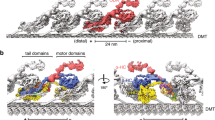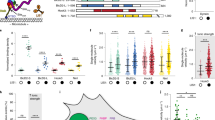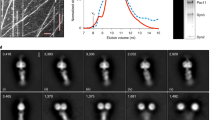Abstract
Flagellar dynein was discovered over 30 years ago as the first motor protein capable of generating force along microtubules1. A cytoplasmic form of dynein has also been identified which is involved in mitosis and a wide range of other intracellular movements2 (reviewed in ref. 3). Rapid progress has been made on understanding the mechanism of force production by kinesins and myosins4,5,6,7,8. In contrast, progress in understanding the dyneins has been limited by their great size (relative molecular mass 1,000K–2,000K) and subunit complexity. We now report evidence that the entire carboxy-terminal two-thirds of the 532K force-producing heavy chain subunit is required for ATP-binding activity. We further identify a microtubule-binding domain, which, surprisingly, lies well downstream of the entire ATPase region and is predicted to form a hairpin-like stalk. Direct ultrastructural analysis of a recombinant fragment confirms this model, and suggests that the mechanism for dynein force production differs substantially from that of other motor proteins.
This is a preview of subscription content, access via your institution
Access options
Subscribe to this journal
Receive 51 print issues and online access
$199.00 per year
only $3.90 per issue
Buy this article
- Purchase on Springer Link
- Instant access to full article PDF
Prices may be subject to local taxes which are calculated during checkout





Similar content being viewed by others
References
Gibbons, I. R. & Rowe, A. Dynein: a protein with adenosine triphosphatase activity from cilia. Science 149, 424–426 (1965).
Paschal, B. M. & Vallee, R. B. Retrograde transport by the microtubule associated protein MAP 1C. Nature 330, 181–183 (1987).
Vallee, R. B. & Sheetz, M. P. Targeting of motor proteins. Science 271, 1539–1544 (1996).
Kull, F. J., Sablin, E. P., Lau, R., Fletterick, R. J. & Vale, R. D. Crystal structure of the kinesin motor domain reveals a structural similarity to myosin. Nature 380, 550–555 (1996).
Sablin, E. P., Kull, F. J., Cooke, R., Vale, R. D. & Fletterick, R. J. Crystal structure of the motor domain of the kinesin-related motor ncd. Nature 380, 555–559 (1996).
Woehlke, G. et al. Microtubule interaction site of the kinesin motor. Cell 90, 207–216 (1997).
Rayment, I. et al. The three-dimensional structure of myosin subfragment 1: a molecular motor. Science 261, 50–58 (1993).
Ruppel, K. M. & Spudich, J. A. Structure–function analysis of the motor domain of myosin. Annu. Rev. Cell Dev. Biol. 12, 543–573 (1996).
Porter, M. E. & Johnson, K. A. Dynein structure and function. Annu. Rev. Cll Biol. 5, 119–151 (1989).
Holzbaur, E. L. F. & Vallee, R. B. Dyneins: molecular structure and cellular function. Annu. Rev. Cell Biol. 10, 339–372 (1994).
Mikami, A., Paschal, B. M., Mazumdar, M. & Vallee, R. B. Molecular cloning of the retrograde transport motor cytoplasmic dynein (MAP 1C). Neuron 10, 787–796 (1993).
Mazumdar, M., Mikami, A., Gee, M. A. & Vallee, R. B. In vitro motility from recombinant dynein heavy chain. Proc. Natl Acad. Sci. USA 93, 6552–6556 (1996).
Gibbons, I. R. et al. Photosensitized cleavage of dynein heavy chains: cleavage at the “V1 site” by irradiation at 365 nm in the presence of ATP and vanadate. J. Biol. Chem. 262, 2780–2786 (1987).
Gibbons, I. R., Gibbons, B. H., Mocz, G. & Asai, D. J. Multiple nucleotide-binding sites in the sequence of dynein β heavy chain. Nature 352, 640–643 (1991).
Ogawa, K. Four ATP binding sites in the midregion of the β-heavy chain of dynein. Nature 352, 643–645 (1991).
Koonce, M. P. & Samso, M. Overexpression of cytoplasmic dynein's globular head causes a collapse of the interphase microtubule network in Dictyostelium. Mol. Biol. Cell 7, 935–948 (1996).
Kanai, Y. et al. Expression of multiple tau isoforms and microtubule bundle formation in fibroblasts transfected with a single tau cDNA. J. Cell Biol. 109, 1173–1184 (1989).
Mitchell, D. R. & Brown, K. S. Sequence analysis of the Chlamydomonas alpha and beta dynein heavy chain genes. J. Cell Sci. 107, 635–644 (1994).
Biou, V., Yaremchuk, A., Tukalo, M. & Cusack, S. Acrystal structure of T. Thermophilus seryl-tRNA synthetase complexed with tRNASer. Science 263, 1404–1410 (1994).
Stebbins, C. E. et al. Crystal structure of the GreA transcript cleavage factor from Escherichia coli. Nature 373, 636–640 (1995).
Goodenough, U. W. & Heuser, J. E. Substructure of the outer dynein arm. J. Cell Biol. 95, 798–815 (1982).
Goodenough, U. W. & Heuser, J. E. Structural comparison of purified dynein proteins with in situ dynein arms. J. Mol. Biol. 180, 1083–1118 (1984).
Amos, L. A. Brain dynein crossbridges microtubules into bundles. J. Cell Sci. 93, 19–28 (1989).
Haimo, L., Telzer, B. R. & Rosenbaum, J. L. Dynein binds to and crossbridges cytoplasmic microtubules. Proc. Natl Acad. Sci. USA 76, 5759–5763 (1979).
Porter, M. E., Knott, J. A., Gardner, L. C., Mitchell, D. R. & Dutcher, S. K. Mutations in the SUP-PF-1 locus of Chlamydomonas reinhardtii identify a regulatory domain in the β-dynein heavy chain. J. Cell Biol. 126, 1495–1507 (1994).
Smith, E. F. & Sale, W. S. Regulation of dynein-driven microtubule sliding by the radial spokes in flagella. Science 257, 1557–1559 (1992).
Heuser, J. E. Procedure for freeze-drying molecules adsorbed to mica flakes. J. Mol. Biol. 169, 155–195 (1983).
Steuer, E. R., Heuser, J. E. & Sheetz, M. P. Cytoplasmic dynein and ciliary outer arm dynein: a structural comparison. Cell Motil. Cytoskel. 11, 200–201 (1988).
Koonce, M. P., Grissom, P. M. & McIntosh, J. R. Dynein from Dictyostelium: Primary structure comparisons between a cytoplasmic motor enzyme and flagellar dynein. J. Cell Biol. 119, 1597–1604 (1992).
Lupas, A., Van Dyke, M. & Stock, J. Predicting coiled coils from protein sequences. Science 252, 1162–1164 (1991).
Acknowledgements
We thank A. Mikami, P. Okamoto, S. Hughes, C. Echeverri, E. Luna, C. Wilkerson and U. Goodenough for discussions; P. McNulty for assistance in the preparation of this manuscript; R. Roth for technical assistance; M. Morgan for computer graphics for the EM images; E. Steuer for cytoplasmic dynein; and U. Goodenough for axonemal dynein.
Author information
Authors and Affiliations
Corresponding author
Rights and permissions
About this article
Cite this article
Gee, M., Heuser, J. & Vallee, R. An extended microtubule-binding structure within the dynein motor domain. Nature 390, 636–639 (1997). https://doi.org/10.1038/37663
Received:
Accepted:
Published:
Issue Date:
DOI: https://doi.org/10.1038/37663
This article is cited by
-
Lis1 activates dynein motility by modulating its pairing with dynactin
Nature Cell Biology (2020)
-
Directionality of dynein is controlled by the angle and length of its stalk
Nature (2019)
-
Overview of the mechanism of cytoskeletal motors based on structure
Biophysical Reviews (2018)
-
Cytoplasmic dynein binding, run length, and velocity are guided by long-range electrostatic interactions
Scientific Reports (2016)
-
Tension on the linker gates the ATP-dependent release of dynein from microtubules
Nature Communications (2014)
Comments
By submitting a comment you agree to abide by our Terms and Community Guidelines. If you find something abusive or that does not comply with our terms or guidelines please flag it as inappropriate.



